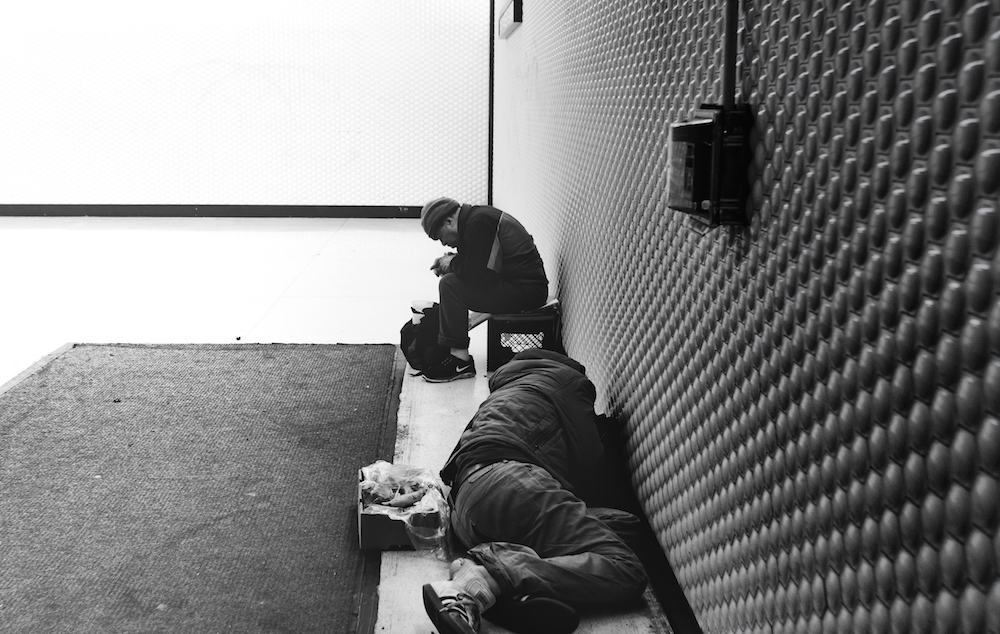Mental illness. Physical injury. Substance abuse. A person experiencing homelessness likely faces an accumulation of adversities and associated health risks such as these. This is why social workers addressing homelessness must implement a holistic approach, says Heather Larkin, an associate professor at the Steve Hicks School of Social Work.

That’s what the National Homelessness Social Work Initiative aims to do through fostering university-community partnerships, empowering student leadership, and expanding regional networks among social work schools across the country. Led by Larkin and funded by the New York Community Trust, the initiative relocated in 2017 to UT Austin from the University at Albany-SUNY as it continues to prioritize homelessness in the social work profession.
Larkin answered questions regarding the impact the initiative seeks to have through relocation and the development of its future goals.
Tell us about a little bit about how this initiative and how it began.
A few years ago, while I was still at University at Albany-SUNY, we received funding to start the National Center for Excellence in Homeless Services. The idea was for it to be a national consortium of social work schools. Once we built a website and held regional symposia, the New York Community Trust invited us to submit an application to fund a national homeless social work initiative.
It was really exciting that the New York Community Trust wanted to work on this because it allowed us to reach out to more social work schools to advance this idea of paying more attention to the issue of homelessness. This, in turn, created connections among faculty and researchers across schools. We looked at how we could strengthen partnerships between social work schools and local homelessness agencies regardless of whether they employed professional social workers or not.
The funding also supports our engagement of policymakers who can help systematize the translation of research into practices that strengthen homeless services. For example, the use of housing first, trauma-informed programs and critical-time intervention. At the same time, we learned about innovations on the ground in each community that we were able to bring into the classroom, like the service coordination achieved through the Coalition for Homelessness Prevention & Intervention (CHIP) in Indiana – closely partnered with the Indiana University School of Social Work.
What motivated the creation of the initiative?
There is a continuing gap in knowledge about homelessness within social work. We say in our code of ethics that we prioritize the most vulnerable and disadvantaged population groups, yet when we break up our research into categories and sub-populations, it creates a gap in understanding and resources for people who are experiencing complex, co-occurring issues.
One of the things we’re seeking to do with this initiative is to put all the pieces of research together. To do this, we’re engaging faculty members across the nation to look at the work they’re already doing to understand how it might be addressing some aspect of homelessness. We want to help people infuse more of that integrative way of thinking into their work and into their teaching.
Why did the project relocate to The University of Texas? What made Austin stand out?
Professor Cal Streeter and others here at the Steve Hicks School of Social Work have a really strong history of connections into the community around addressing homelessness. And UT Austin was already one of our regional leader schools. The first year we had funding from the New York Community Trust, we asked all of our partner schools to report on the baseline content each had about homelessness: What kind of courses did they offer about homelessness? What community relationships existed? What field placements were available to students? I have to tell you, UT Austin had one of the most thorough reports about the work done by different faculty members and within different classes offered.
And the city of Austin seems to be unique compared to other communities because there are trained social workers in a number of homeless service settings as well as students placed in and working in homeless services for their internships.
I think Austin is ahead of the game in that ability to bring social work knowledge and translate the research into practice in this field. There are some really strong field placements already set up here. For example, professor Streeter had already started a stipend program for social work students in their internships who learn how to use SOAR, a national program to help people get connected to their benefits. There is a workforce retention problem with people trained in SOAR, which inhibits clients from getting connected to their benefits to effectively prevent or address homelessness in their lives. By ensuring that social work students interning in homeless services agencies are trained in SOAR, we are immediately responding to a community need. In addition, the stipend program is an example of how the Steve Hicks School of Social Work is creating a pathway for students into leadership roles in this field.
By Lynda Gonzalez. Posted November 6.


